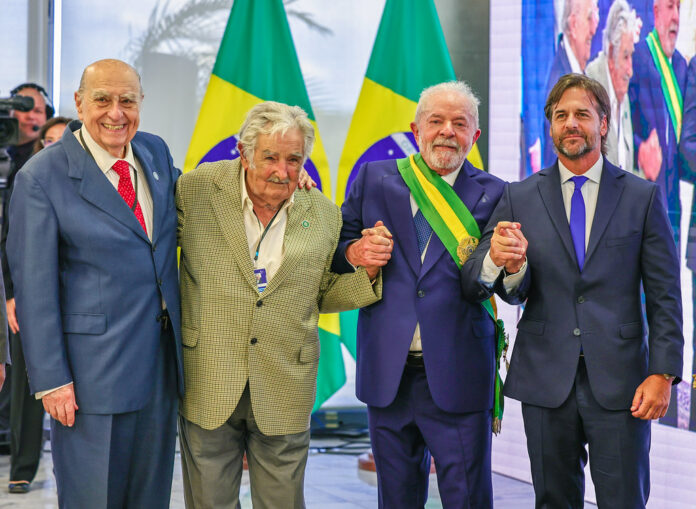Lula and the neighbors: Brazilian President Lula da Silva in the presidential sash, with Uruguayan President Luis Alberto Lacalle Pou to his left and to his right to former presidents of Uruguay, Pepe Mujica and Julio Sanguinetti. Photo by the Brazilian Presidency.
Brazil’s economic challenges are again Lula’s to
tackle – this time around they’re more daunting
by Marc-Andreas Muendler, University of California, San Diego and Carlos Góes, University of California, San Diego
Even when they’re in trouble, Brazilians rarely lose their sense of humor. But in recent years, their joviality has often given way to political division everywhere from social media to the dinner table.
One familiar quip – that Brazil is the country of the future and always will be – has lost its levity as Luiz Inácio Lula da Silva begins his third presidential term. Lula previously led his country from 2003 to 2010. The president, who was sworn in again on Jan. 1, 2023, promised on the campaign trail that Brazil’s future can be like its past again: more prosperous and less polarized.
Having studied Brazil in our economic research, and having lived in the country for several years by birth or by choice, we argue that it will not be easy for Lula to fulfill his economic promises.
Unlike in his first two terms, when domestic and foreign markets helped the economy along, Lula now faces strong headwinds at home and abroad – and that means sound policies are even more important this time around.
Good times, bad times and economic choices
Brazil shot up from the world’s 14th-largest economy in 2003 to the seventh-biggest in 2010, during a boom that largely coincided with Lula’s prior presidency. At the same time, the country’s poverty rate, which the World Bank today pegs at the share of the population living on less than US$3.65 a day, fell sharply, from 26% to 12%.
Brazil exports so many gallons of orange juice, bags of coffee, bushels of wheat and other commodities that it’s serving up the world’s breakfast. Global growth during those years boosted the demand for these commodities as well as for Brazil’s processed goods. Manufacturing exports fueled Brazil’s growth in the decade following the year 2000 for the first time, led by sales of products like steel, car parts and cars, and aircraft made by Embraer.
During these boom years, Lula ran a balanced government budget, held inflation low and kept the Brazilian real’s exchange rate with other currencies under control – macroeconomic policies that he maintained from his predecessor, Fernando Henrique Cardoso. Lula also bundled Cardoso’s popular anti-poverty programs into Bolsa Família, a successful conditional cash transfer program. To remain enrolled and receive the monetary benefits, low-income families had to get their children vaccinated against diseases, keep them in school and meet other requirements.
Cynthia Benedetto, Embraer’s chief financial officer, observed in 2011: “Since my childhood I heard that Brazil is the country of the future,” and then warned, “Now the future has arrived, and I start to fear that it is short.”
She was right. The good times didn’t last.
During the second decade of this century, the prices of many of the commodities that Brazil exports fell or even plummeted. The country experienced two of the worst recessions in its history. In the downturn that lasted from late 2014 to mid-2016, nearly 5 million Brazilians lost their jobs. After a sluggish recovery, the COVID-19 pandemic hit, and 10 million Brazilians became jobless in another big downturn.
Political upheaval
Bad choices made tough and unlucky times worse.
A combination of economic mismanagement, widespread corruption, political turmoil and a global pandemic all contributed to 10 years of backward sliding after a decade of progress.
Lula’s allies, including some in his inner circle, were found to be part of one corruption scheme after another. Lula himself ended up in prison for corruption until Brazil’s Supreme Court declared the case a mistrial because the presiding judge was determined to have been biased.
Brazilians elected Lula’s hand-picked successor, Dilma Rousseff, in the 2010 and 2014 presidential races. She cast aside some of her predecessors’ policies that had buttressed economic stability.
Rousseff ended the central bank’s de facto independence and lowered interest rates in an abrupt turnaround that sparked inflation. She gave up on balancing the budget.
Once corruption was exposed in state-owned oil company Petrobras, the construction industry and at Brazil’s massive state-run development bank, economic activity slowed across the board. Rousseff oversaw one of Brazil’s most severe economic contractions in memory: GDP shrank by 7% and public debt increased 20 percentage points as a share of GDP from 2014 to 2016.
Brazil’s Congress impeached and convicted Rousseff in 2016 for fiscal improprieties. Her vice president, Michel Temer, served out the rest of her term and appointed Lula’s central bank chair, Henrique Meirelles, as minister of finance to help rein in public debt.
Jair Bolsonaro, a vocal admirer of Brazil’s 20th-century military dictatorship, became president in 2019 by riding the wave of widespread sentiment against Lula’s and Rousseff’s Workers’ Party. Bolsonaro prioritized short-term political gain over long-term adjustment, often clashing with his own economic aides and dodging rules meant to curb government spending.
By 2020, Brazil’s economy ranked No. 12 in the world in terms of GDP, and living conditions deteriorated. In 2021, the poverty rate likely hit the highest level in a decade, according to estimates by researchers at IPEA, a government think tank, as well as IBGE, Brazil’s statistics agency.
The pandemic and the social spending fluctuations it brought about have made it hard to accurately track economic trends in recent years. But the numbers suggest that Brazil is close again to where it started the 21st century.
Back to the future
Lula’s economic challenges are daunting, over and above the political crisis after the riots by opposition supporters in Brasília.
First, the economic outlook is gloomy. Inflation has led central banks worldwide to increase interest rates, and the International Monetary Fund forecasts a global slowdown in 2023.
Even if the world still wants Brazil’s coffee, orange juice and cereal from wheat or corn for breakfast, we doubt that foreign demand for Brazil’s exports will bounce back to the levels seen in past boom years.
Global prices for many of the commodities Brazil exports have been sliding downward for the past 15 years. They briefly reached their 2008 peak level again in mid-2022, partly driven by Russia’s invasion of Ukraine and the ensuing global turmoil that drove food prices up.
But the prices of commodities that are particularly important to Brazil, such as soybeans, corn and coffee, are all down significantly from their recent peaks.
During his 2022 campaign, Lula promised to slash taxes on the upper-middle class and increase benefits for the poor while keeping government finances under control.
This arithmetic is feasible in an era of rapid growth, when newly generated wealth can finance public transfers. At times of slow or no growth, like today, it becomes much harder to pull off.
Second, unlike when Lula first took office following a period of fiscal stability, this time he must credibly rebuild much of the fiscal framework.
After boosts to benefits, tax cuts and some unfunded pension commitments to retirees, it’s become hard to balance Brazil’s budget. In response to the crisis in the mid-2010s, Brazil’s Congress passed a spending cap that gradually rises so as to foster slow fiscal adjustment while avoiding harsh austerity. But Bolsonaro essentially got rid of the cap by circumventing it.
One example is the federal government’s obligation to cover court-mandated payments: Bolsonaro delayed the disbursement of 110 billion reais ($21.6 billion), equal to more than 1% of Brazil’s GDP, in 2022. That means the new government has to pay this year’s and some of last year’s bills at the same time.
While Bolsonaro dismissed the severity of COVID-19 when it was spreading uncontrolled through his country, his government did help people cope with its economic fallout by allowing emergency spending that breached Brazil’s spending cap. However, his administration maneuvered to perpetuate the state of emergency and kept spending levels higher than the cap would allow long after Brazilians stopped staying at home for public health reasons.
Third, we expect political divisions, including some within Lula’s administration, to be another obstacle. Different factions on his economic team are likely to be at loggerheads for the foreseeable future because they prefer starkly different policies.
Simone Tebet, the new economic planning minister who is in charge of coordinating spending, has several fiscal conservatives on her team.
Finance Minister Fernando Haddad, in contrast, has appointed undersecretaries known to invariably advocate for more spending. Plans for taxes and spending released to date set a budget surplus of 0.5% of GDP as the new government’s target, primarily financed with more tax collection.
Using budget projections by the International Monetary Fund, we consider those revenue projections overly optimistic.
To be sure, any new government deserves time to prove itself, especially under tough circumstances. But patience is rarer in Brazil than humor – and always has been.![]()
Marc-Andreas Muendler, Professor of Economics, University of California, San Diego and Carlos Góes, Doctoral Candidate in Economics, University of California, San Diego
This article is republished from The Conversation under a Creative Commons license. Read the original article.
Contact us by email at fund4thepanamanews@gmail.com
To fend off hackers, organized trolls and other online vandalism, our website comments feature is switched off. Instead, come to our Facebook page to join in the discussion.
These links are interactive — click on the boxes












